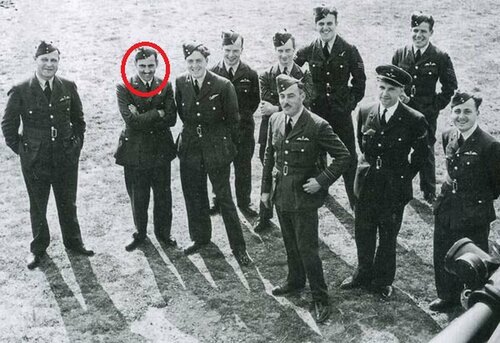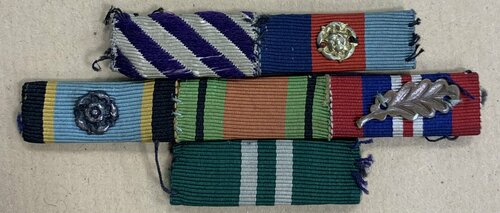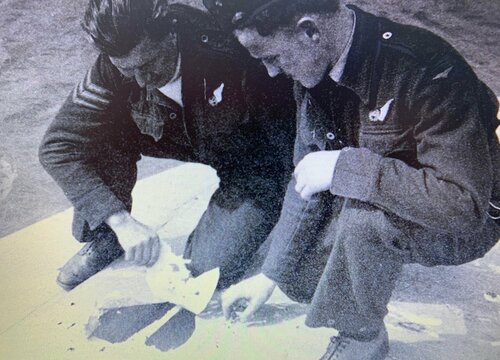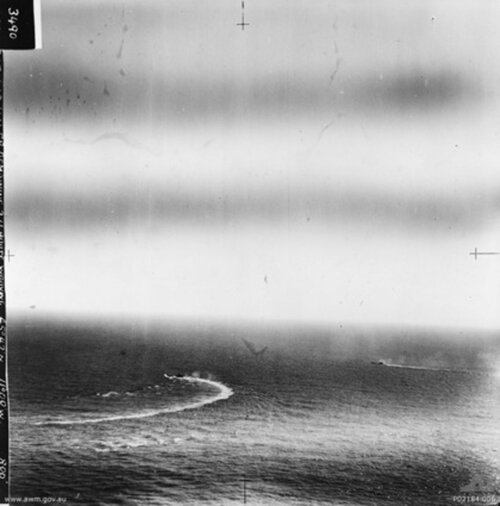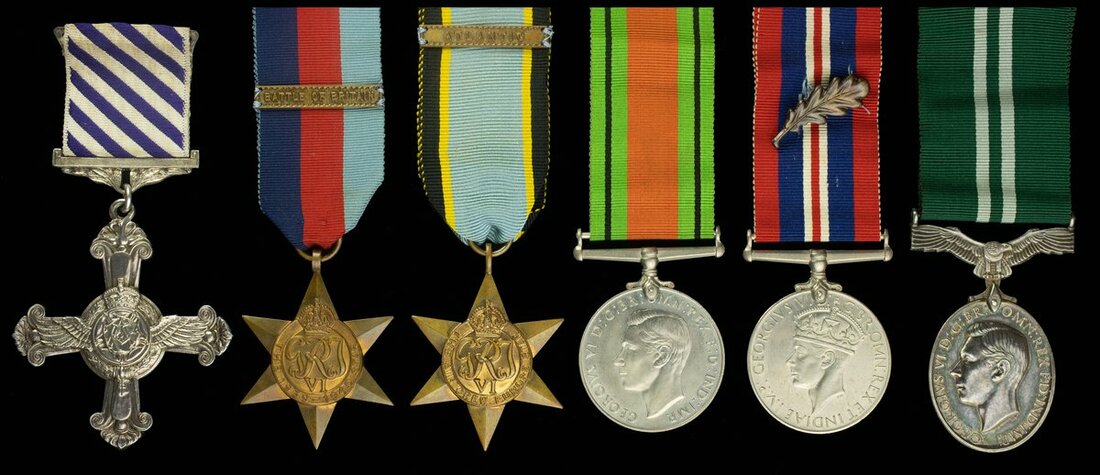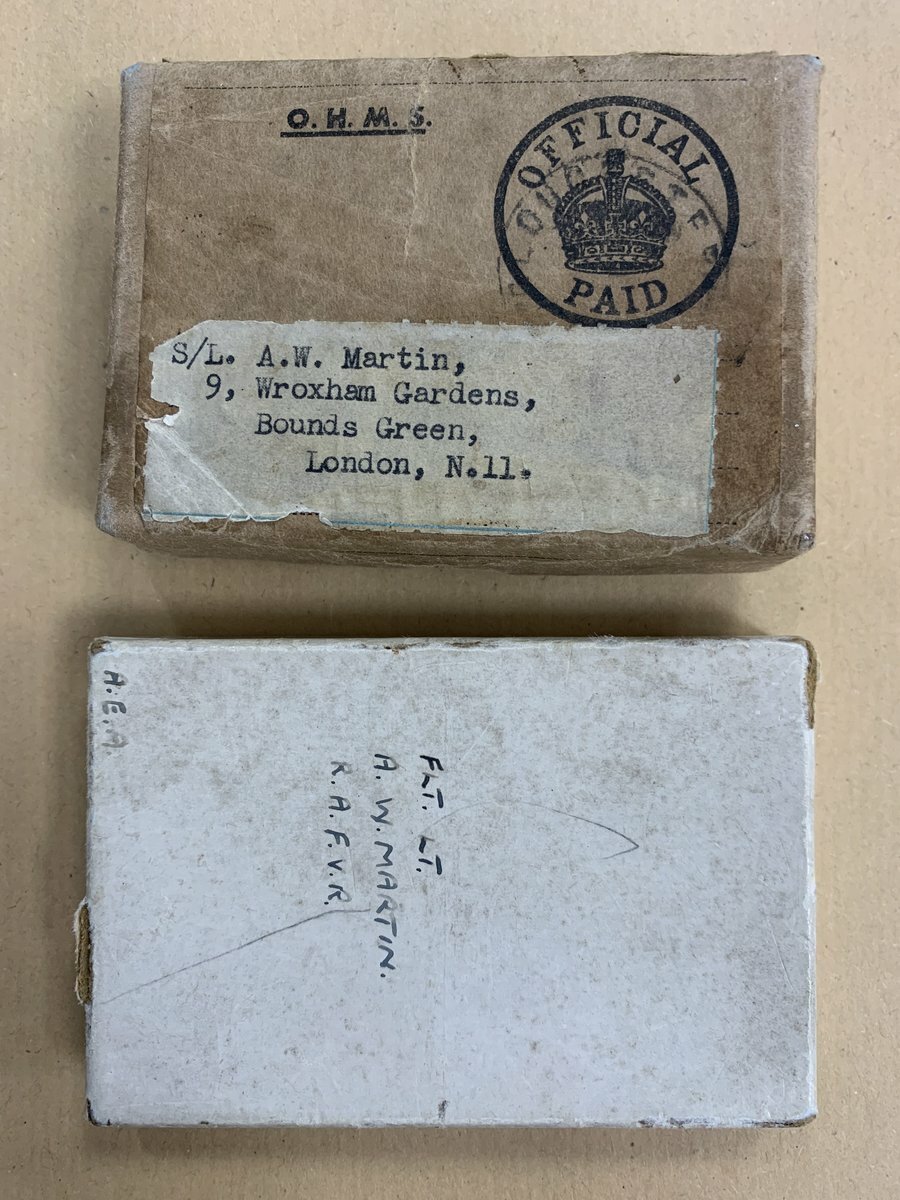Auction: 22101 - Orders, Decorations and Medals - e-Auction
Lot: 439
A fine Second World War 'Coastal Command' D.F.C. group of six awarded to Squadron Leader A. W. Martin, Royal Air Force Volunteer Reserve, a Battle of Britain veteran who flew a plethora of Ops, sharing in heavy action on 15 August 1940, who was latterly decorated for successful anti-U-boat operations over the Bay of Biscay in the summer of 1943, not least for his part in the destruction of the U-462 on 30 July
Distinguished Flying Cross, G.VI.R., reverse officially dated ‘1943’; 1939-45 Star, clasp, Battle of Britain; Air Crew Europe Star, clasp, Atlantic; Defence and War Medals 1939-45, with M.I.D. oak leaf, these four in their card box of issue addressed to 'S/L. A. W. Martin, 9, Wroxham Gardens, Bounds Green, London, N.11.'; Air Efficiency Award, G.VI.R., 1st issue (Flt. Lt. A. W. Martin, R.A.F.V.R.), officially engraved naming, in its named card box of issue, together with a set of wartime tunic ribands, including the gilt rosette denoting 'Battle of Britain' to the 1939-45 Star, extremely fine (6)
D.F.C. London Gazette 7 December 1943.
Allan William Martin, a native of Bounds Green in North London, was born in 1914, entered the Royal Air Force Volunteer Reserve in February 1939. Qualifying as an Observer, and commissioned as a Pilot Officer in late March 1940 and joined No. 235 Squadron on 1 April 1940, a fighter reconnaissance unit of Coastal Command equipped with Blenheims. Based at Bircham Newton, the Squadron flew sorties over Holland during the German invasion of the Low Countries and, during the Battle of Britain, convoy protection and reconnaissance patrols over the North Sea.
The role of Coastal Command during the events of summer 1940 has tended
to be overlooked, but whether in the Battle of France or the Battle of Britain its units contributed significantly and tirelessly. This was the case when the British Expeditionary Force was evacuated from Dunkirk under Operation ‘Dynamo’, actions in which Squadrons of Bristol Blenheim IVFs that
detached to RAF Detling near Maidstone, Kent, were heavily engaged. No. 235 Squadron had been stationed at Bircham Newton, Norfolk. On 26 May 1940, the same day they were payed a visit by HM The King, it transferred to Detling in order to conduct patrols over the English Channel while ‘Dynamo’ was ongoing and coastal reconnaissance covering the Channel ports. The first of these took place the day after the move to Kent, Blenheims L9404 and L6909 carrying out a recce off Nieuwpoort in Belgium. It proved to be an eventful occasion, for having been 'buzzed' by 15 enemy fighters, they came across three enemy aircraft, engaging and damaging them all. Again, three of his comrades went into the thick of the action over Dunkirk, soon finding themselves swarmed by enemy fighters, led by Hauptmann Adolf Galland. The Blenheims never stood a chance and all three crews were shot from the sky.
Martin served throughout the Battle of Britain as Observer to Flying Officer Laughlin, with Sergeant Leo Ricks as their Air Gunner. Their Ops in the period are as follows (all from handwritten Operational Record Books, thus dates sometimes vary):
'5.5.40 Blenheim IV L9404 Escort to mine layer.
6.5.40 Fighter escort returned because of fog.
9.9.40 To Manston Instruction from No1 GPO Unit.
10.5.40 Escorting convoy from Antwerp.
12.5.40 L9259 Offensive patrol covering 'warships' attacked by 5 Me 110's-one seen to crash.
13.5.40 Air cover for embarking Marines Hook of Holland.
15.5.40 L9404 Offensive Patrol Ostende - Heinkel sighted -no combat.
17.5.40 Protection of trawlers under attack from Heinkels- attacked by 4 Hurricanes opening fire, then attacked by 3 Spitfires no casualties.
19.5.40 L9259 Fighter Patrol escorting Trawlers and destroyers carrying out special operations.
19.5.40 2nd patrol similar (1725-2135hrs).
20.5.40 L9396 Reco Flushing occupied by enemy.
24.5.40 L9404 Operation to escort Belgium Government from Dunkirk-Dover - Op cancelled.
27.4.40 P6957 2x Patrols Dover-Calais Ostende.
30.5.40 N 3541 Recco- Calais Dunkirk Goodwin Sands (Appendix outlining a lot of activity around Dunkirk and Op Dynamo thousands of troops seen on beaches and sea craft- all seen by the Squadron Blenheims).
1.6.40 L9404 Patrol Goodwin Sands/Dunkirk.
2.6.40 Patrol Dunkirk.
5.6.40 Recco Dunkirk.
9.6.40 Escort convoy Le Havre-Dieppe.
10.6.40 L9447 Cherbourg.
11.6.40 L9393 Offensive Patrol St Valerie-Cherbourg.
15.6.40 N3533 Fighter Patrol Cherbourg
16.6.40 N3534 Fighter Patrol Thorney Island-Bordeaux return bad weather.
24.6.40 Recco River Maas.
26.6.40 Search for downed aircraft in North Sea.
27.6.40 N3540 Escort to MTB's returning from Flushing.
2.7.40 P4833 Recco off Dutch Coast.
4.7.40 Escorting Hudsons from No. 206 Squadron.
7-11.7.40 Intensive training of all crews in air combat and daily physical training.
[Battle of Britain begins 10 July 1940]
11.7.40 Search of Wash for reported a/c in sea - nothing found.
19.7.40 Convoy Patrol Recco Emden 2 patrols flown
20.7.40 Escorting mine layers.
21 & 22.7.40 Routine Convoy Patrols.
23.7.40 Escorting mine layers.
24.7.40 Convoy Patrol.
25.7.40 Convoy patrol at dawn then protecting mine layers.
27.7. & 2.840 Protecting mine layers.
3.8.40 Convoy escort (Ken Wynn credits crew with He 115 - ORB shows Fletcher/Peacock/Westlake on their return from Recco of Danish Coast attacking He115 crashing into sea).
7.8.40 One of 6 Blenheims making a mock attack on aerodrome for training.
12.8.40 Protection for mine layers.
13.8.40 Escorting MTB's to Le Havre.
14.8.40 Destroyer Escort from Bircham Newton.
15.8.40 Sweep of Danish Coast with two other Blenheims about 40 enemy aircraft seen returning from raid on England, one He111 shot down by the Gunner of Jackson Smith's crew, remaining two Blenheims drove down He 111 only one engine- rear gunner silenced. Remaining enemy aircraft made off. On their return the Blenheims attacked small enemy ship with their machine guns.
16.8.40 Two escort patrols carried out.
17.8.40 Both A & B Flights escorted Fairy Battles having bombed Boulogne.
19.8.40 Group Captain Primrose congratulated Squadron for fighting spirit resulting in 6 enemy aircraft destroyed in past 10 days.
21 & 29.8.40 Fighter patrols over Thorney Island.
1.9.40 Destroyer escort.
3.9.40 Search North Sea for downed aircraft - not found.
5.9.40 Sweep of Danish Coast.
11.9.40 A & B Flights escorting bombers on Calais - formation attacked by Me 109's and AA co-operating with No. 59 Squadron formation attacked 4 Me109's.
13-29.9.40 Aerodrome protection Thorney Island.
30.9.40 Recco Caen.
2.10.40 Recco Cherbourg.
7.10.40 Sweep Danish Coast.
It appears the crew went on leave from 7 October, for their next Op was flown on 10 November, after the closing of the Battle of Britain.
Andrew Bird, in Coastal Dawn - Blenheims in Action from the Phoney War through the Battle of Britain gives more detail on their action on 15 August, with good mention of Martin:
'On Thursday August 15th the Luftwaffe launched an attack using the German - based Luftflotte 5 in Norway against aerodromes at Usworth and Dishforth utilising Heinkels of 8/KG 26 and 1/ZG 76 Bf's 110's. When the main force steamed in all was going well until a catastrophic navigational 3 degree error saw 65 Heinkels and 34 Me 110's tracking towards the Firth of Forth. Realising their mistake the formation turned South flying at 15,000ft. 72, and 605 squadrons were scrambled, along with 41 and 79, many bombers were shot down before the ramshackle formation were in full retreat across the North Sea around 13.45hrs.
In the afternoon someone at 16 Group had the bright idea to send 3 Blenheims out on a shipping raid, along the Danish coast. The pilots Laughlin, Hall and Jackson - had been warned that Spitfires and Hurricanes were on ops in the area. Leading the arrowhead, Laughlin in L 9404 dipped his wings on the lookout as he led T1803 and T1084 with the sun glinting off the North Sea.
At 14.55 hrs T1803's pilot Jackson-Smith spotted black specs on the sky-line - his observer shouted out 'Heinkels,' while Jackson-Smith manoeuvred his aircraft into attack with his belly pack of machine guns. At the same time his rear gunner emptied a full magazine into the enemy. F/O Laughlin in 'A'-Ace L9404 and Sgt Hall in 'E'-Edward T1804 waded into the melee, finding 15 He111's at 3,000ft, and 3 stragglers at 1500ft. Wheeling in from astern they picked one out and fired their guns. The He111 engines spluttered to a halt, and rounds were seen to prize open the rear fuselage with no return fire. Further attacks were made on a second Heinkel.
Laughlin raced in as it began to jink, 'he started turning one way and then the other as the gunner loosed off wildly, I would hardly need my sight. Fired longish bursts then whitish smoke came from one engine. It went down to sea level making for Denmark.'
The Heinkels were now going like hell and the Blenheims headed for home. At 15.40 Laughlin and Hall both received incoming fire from tracers over the North Sea from an unidentified ship travelling at 4 knots. Laughlin and Hall yanked their aircraft in a 180 turn and hit back with a salvo of 6x 20lb GP bombs along with 2 incendiaries. Explosions rocked the vessel and the machine guns fell silent. Their troubles were not yet over as they flew straight over two trawler type vessels, known as 'flak-ships' who pumped out defensive fire of all calibres, with no effect. Laughlin's Observer P/O Bill Martin remarked:
'Stupid Hun were firing blanks, very inaccurate bursts of black smoke observed.'
Both Blenheims landed safely at 1900 hrs. P/O Martin climbed wearily down from the aircraft, heading for the dispersal hut followed by Laughlin and the Canadian gunner Sergeant Leo Ricks. In the ensuing debrief it was recorded that each Blenheim had fired 2250 rounds from the front guns and 1700 from the rear. Jackson-Smith was credited with one Heinkel 111 H-4 of 8 /KG 26. (5 in all from this unit destroyed on this day). After a celebratory drink in the officers mess, they all headed for bed at 2200hrs.'
Martin was advanced to Flight Lieutenant in March 1942. He was next posted to No. 502 (Ulster) Squadron, another Coastal Command unit, equipped with Halifaxes, and it was in this capacity, as a member of Flying Officer A. van Rossum’s crew, that he participated in a memorable action in the Bay of Biscay on 30 July 1943 - on which date two U-Boats were destroyed by Coastal Command aircrew and a third by Captain “Johnnie” Walker, R.N.
Arriving over the Bay after a general action had commenced with all three U-Boats, van Rossum carried out a determined and accurate attack on the U-462. Conflict Over the Bay, by Norman Franks, takes up the story:
‘The American Liberator made another attack, also from low level and was hit by gunfire from U-504. This smashed the Liberator's release gear, causing the D/Cs to hang-up. Van Rossum then dropped his third bomb on U-462, but his first bomb had caused enough damage already and she had begun to sink. About 40 of her crew were taking to dinghies or diving into the water. The American pilot made another run but even when they used the jettison mechanism, the D/Cs failed to release. Van Rossum recorded:
“We were right over it as it began to go down slowly. As it sank lower and lower more and more men came running along the deck and jumped into the water. When only the conning tower was left above water we saw shell splashes off to one side. The Navy had arrived and the sloops were shelling our sinking U-boat. They were too late for this, though, and all the men had jumped overboard.”
By this time, Captain Walker's ships were fast approaching -just five miles off. Seeing these on the horizon, U-504 crash-dived, ending the air action which had lasted just eighteen minutes from van Rossum's first bomb.
The Escort Group radioed van Rossum, asking what was happening. He replied that two U-boats had been sunk and that the third had dived, on a westerly heading. The hunt was started for U-504 and at 12.34 am an asdic contact was made. However, asdic conditions were not good and D/C attacks were not made until 1.49. These lasted for some time until, in the mid-afternoon, oil, wreckage and human remains came to the surface, confirming the death of U-504. The Bay's air and surface forces had destroyed completely, a whole U-boat group. With the last kill confirmed, Walker's ships returned to the area of U-461 and 462's sinkings to pick up the survivors, H.M.S. Woodpecker taking Stiebler and his men on board.’
Martin was awarded the D.F.C. and added a mention in despatches to his laurels before War’s end (London Gazette 1 January 1945, refers). He was released from the R.A.F.V.R. in the rank of Squadron Leader and received his Air Efficiency Award in August 1948.
Martin is seen in a photograph taken from the port wing of N3530, showing members of No. 235 Squadron, taken at Bircham Newton on 5 October 1940. He is standing besides Flying Officer N. B. Shorrocks, shot down and killed leading an escort attack for Albacores of the Fleet Air Arm on Calais, whilst Sergeant P. F. Hall is stood two to his left, was shot down in 1943 and held at Stalag Luft III.
A striking image of U-462 and U-461 attempting to take evasive action on the day of the sinking of the former was also captured, with another of crew inspecting damage to a wing from the same action also captured.
Subject to 20% VAT on Buyer’s Premium. For more information please view Terms and Conditions for Buyers.
Sold for
£8,000
Starting price
£5000


